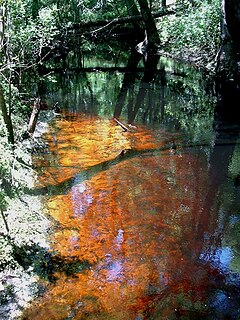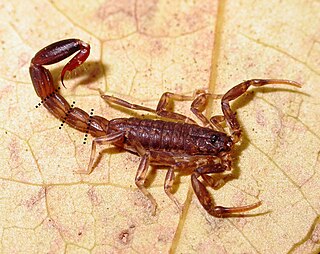
Huila is one of the departments of Colombia. It is located in the southwest of the country, and its capital is Neiva.

The Magdalena River is the principal river of Colombia, flowing northward about 1,528 kilometres (949 mi) through the western half of the country. It takes its name from the biblical figure Mary Magdalene. It is navigable through much of its lower reaches, in spite of the shifting sand bars at the mouth of its delta, as far as Honda, at the downstream base of its rapids. It flows through the Magdalena River Valley.

A blackwater river is a type of river with a slow-moving channel flowing through forested swamps or wetlands. As vegetation decays, tannins leach into the water, making a transparent, acidic water that is darkly stained, resembling tea. Most major blackwater rivers are in the Amazon Basin and the Southern United States. The term is used in fluvial studies, geology, geography, ecology, and biology. Not all dark rivers are blackwater in that technical sense. Some rivers in temperate regions, which drain or flow through areas of dark black loam, are simply black due to the color of the soil; these rivers are black mud rivers. There are also black mud estuaries.

White-fronted capuchin can refer to any of a number of species of gracile capuchin monkey which used to be considered as the single species Cebus albifrons. White-fronted capuchins are found in seven different countries in South America: Bolivia, Brazil, Colombia, Venezuela, Ecuador, Peru, and Trinidad and Tobago.

The collared titi is a species or a closely related complex of species of titi, a type of New World monkey, from South America.

Radamel Falcao García Zárate is a Colombian professional footballer who plays as a forward for and captains both Monaco and the Colombia national team. He is sometimes nicknamed "El Tigre" or "King of the Europa League".

Amazonía region in southern Colombia comprises the departments of Amazonas, Caquetá, Guainía, Guaviare, Putumayo and Vaupés, and covers an area of 403,000 km², 35% of Colombia's total territory. The region is mostly covered by tropical rainforest, or jungle, which is a part of the massive Amazon rainforest.

The Orinoquía region is one of the five natural regions of Colombia that belongs to the Orinoco River watershed. It is also known colloquially as the Eastern Plains from the Spanish Llanos Orientales. The region covers most of the area of the departments of Meta, Arauca, Casanare and Vichada.

Cumaribo is a town and municipality located in the Department of Vichada, Republic of Colombia. Cumaribo was founded by Jose Nicolino Mattar in 1959.

Because of its natural structure, Colombia can be divided into six very distinct natural regions. These consist of the Andean Region, covering the three branches of the Andes mountains found in Colombia; the Caribbean Region, covering the area adjacent to the Caribbean Sea; the Pacific Region adjacent to the Pacific Ocean; the Orinoquía Region, part of the Llanos plains mainly in the Orinoco river basin along the border with Venezuela; the Amazon Region, part of the Amazon rainforest; and finally the Insular Region, comprising islands in both the Atlantic and Pacific oceans. Colombia is located in South America.

North Santander is a department of the nation of Colombia. It is in the north of the country, bordering Venezuela. Its capital is Cúcuta, one of the country's major cities.

Ananteris is a little-known genus of rare scorpions. It contains 64 species found in South America. Species include:
Neoxyphinus is a genus of spiders in the Oonopidae family. It was first described in 1953 by Birabén. As of 2017, it contains 48 species.

Colombia is the country with the second-highest biodiversity in the world, behind Brazil. As of 2016, 56,343 species are registered in Colombia, of which 9,153 are endemic. The country occupies the first position worldwide in number of orchids and birds, second position in plants, amphibians, butterflies and fresh water fish, third place in species of palm trees and reptiles and globally holds the fourth position in biodiversity of mammals.

The Negro-Branco moist forests (NT0143) is an ecoregion of tropical moist broadleaf forest to the east of the Andes in southern Venezuela, eastern Colombia and northern Brazil, in the Amazon biome. It lies on the watershed between the Orinoco and Rio Negro basins. It includes both blackwater and whitewater rivers, creating different types of seasonally flooded forest. The vegetation is more typical of the Guiana region than the Amazon.















